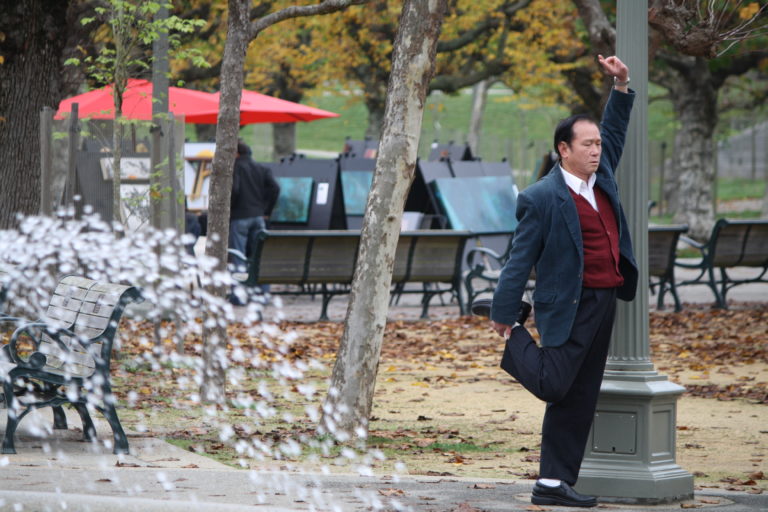
Image by Rosy/Flickr, Attribution-NoDerivs.
The Challenges of Seeing Meditation Only Through a Scientific Lens
Some years ago, a neuroscientist gently challenged me on the benefits of meditation: “Without further scientific validation,” he began, “how will you know if meditation works?”
I gulped, unsure of how to respond, but confident in my belief that meditation works.
“Well, we kind of think we already know it works.” How? Because those of us who have developed meditation practices have been our own laboratories: we feel the benefits of meditation directly in our bodies, in our minds, and throughout our lives in often surprising ways.
Of course, I appreciate the recent surge of research into meditation quite a lot. When I think of the mainstream attention meditation is getting, I then think of the Buddha, telling his first 60 disciples to go forth and teach ”for the good of the many, the welfare of the many.” In fact, the last thing the Buddha suggested to his disciples was that they teach in the local idiom. Meditation shouldn’t have to be pursued in esoteric terms, as its values and perspectives can be expressed in lots of different ways, and its benefits are supposed to relate to our actual lives.
For us, in our time, the equivalent of a “local idiom” is psychology and science. In many ways, I value the way some timeless truths (such as the benefits of meditation) can be expressed in terms that are specific, sharply articulated, and current.
I welcome the intriguing puzzles and nuanced answers neuroscience has introduced to the world about meditation. Who knew that the pleasure center of the brain lights up if someone does a compassion meditation in an fMRI scanner, even if what they are acknowledging and focusing on is the experience of suffering. In doing so, this person wouldn’t be embracing sadism, nor masochism, but embracing a sense of oneness, the commonality of suffering in the human experience. This is what meditation allows us to do — to acknowledge, to observe, to connect. This expansive way of experiencing things lifts us up. It feels good.

I always remind my students that the proof of one’s meditation practice isn’t in the formal period of sitting on the cushion or chair, or doing walking meditation; it’s in your life.
A friend once took me out in NYC, which turned into a kind of confessional lunch. He started out with an admission: “I’ve been doing lovingkindness meditation for about three years now. Yet my experience as I sit each day, three years later, isn’t so radically different from when I started.” He seemed to want an explanation from me, but I just continued to listen, so he continued to share: “But I’m a different person,” he added, “I’m different with myself, with my family and friends, with my community. I’m different ethically. Is that enough?” I laughed and reassured him, “Yeah, I kind of think that’s enough.”
We need to remember to look at our lives for signs — to consider how we are with our partners, our children, our colleagues at work, or even with strangers. Even more importantly, we need to look at how we speak to ourselves when we have made a mistake: do we blame ourselves, or recognize our capacity for resilience, our ongoing ability to begin again.
In other words, we don’t necessarily seek the kinds of results neuroscience is providing. We don’t await the thickening of our prefrontal cortex or our shrinking amygdala or the fact that our telomeres are becoming less frayed over time. Of course, for research purposes, these are wonderful tools, and they are strengthening the support behind meditation world-wide. But this field of study is still in its infancy.
I was on a panel with Richie Davidson from the University of Wisconsin at Madison, and the Center For Investigating Healthy Minds. During the panel, I posed this provocative question to him:
“What if you had a world-renowned meditation teacher come into the lab, someone famous for his or her extraordinary kindness and compassion. You pop them into the fMRI machine and ask them to do compassion meditation. And let’s say the ‘wrong’ part of their brain lights up. Would you think, ‘Hm. Our ability to measure is still in its infancy, we need to refine these tools?’ Or would you suddenly become a skeptic and think, ‘This person has a completely undeserved reputation?’”
Richie’s response was simple: “Science always needs to be humble.”
Science or not, all of us always need to be humble. As a teacher, the idea of meditation and meditation instruction as an art resonates most with me. It’s intuitive, dynamic, sometimes implicit rather than explicit, sometimes subtle rather than concrete. It might make for changed lives but perhaps doesn’t make for very good research.
The foundational change we must make in order to change our lives is to change our relationship to ourselves. Of course, this is arguably the hardest change there is to make. I once did a presentation with Barbara Fredrickson of the University of North Carolina, whose research focuses on positive emotions, and often utilizes lovingkindness meditation as the intervention eliciting positive emotions in her subjects.
During our presentation, Barbara explained that she felt people commit more readily to a meditation practice if they had a positive experience within the first two weeks of trying it out. Ironically, since she begins by teaching the lovingkindness practice, which classically begins with the offering of lovingkindness to oneself, she finds people are more inclined to quit, rather than continue, their practice. The gesture of offering lovingkindness to oneself is a tremendous challenge for mots most of us.
It’s true that classically you begin that particular meditation process by offering lovingkindness to yourself, and it’s certainly true that it can be very difficult. But I felt a moment of astonishment.

I told Barbara and the audience that if I had a living, breathing human being in front of me, struggling in some significant way, I’d change the classical order in a second. I’d have them offer lovingkindness to a beloved friend, to a family member, to a pet — basically to anyone who could begin to open the terrain of what lovingkindneess feels like. Barbara responded by saying that the interests of good science demand replication, and it was harder if different people were doing all kinds of different things in a different order.
While I understood her position, part of me felt like saying, “Suck it up science. Someone may be hurting here.” But the truth is that science too is serving us immeasurably — pioneering the discussion about stress, taking methods of meditation out of the realm of “woo-woo,“ and making the use of them an issue of public health.
We’ll keep having these discussions and explorations as we all try to, out of good motivation try to make this a better world. And to do it in a local idiom.


Share your reflection